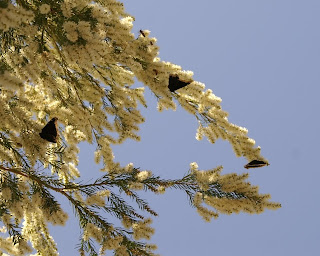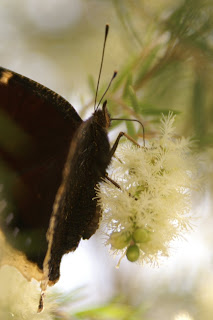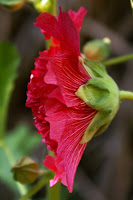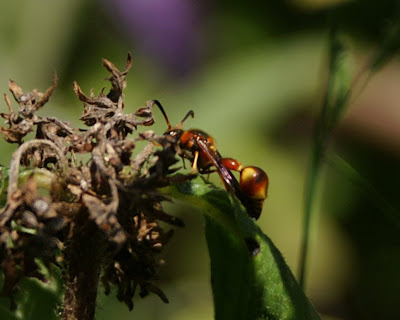
On the south side of our house a
melaleuca linariifolia tree grows, commonly called flaxleaf paperbark or snow in summer. It has spongy bark that sheds in sheets, fragrant needle-like foliage and white bottlebrushy flowers in late spring (in our climate). A week ago the tree came into full bloom during a run of hot dry weather. On Saturday morning as the day heated up, I sat under the tree watching the array of insect species feeding on the nectar and/or pollen the tree offered so abundantly:

First, I have never seen as many butterflies at one time on this property. The photo is a lame attempt to represent the numbers (20 or so) of
Nympalis antiopa visiting the tree at once. These butterflies had been seen flying in fair numbers for about a week. Now they were taking advantage of the tree's nectar along with the convenient or comfortably high roosts it offers. Occasionally a pair would fly off; presumably mating ensued and then egg-laying on the Chinese elm trees that line our street.
A "normal" number of
Vanessa annabella, West Coast Lady, came and went. The caterpillars of this species like to eat plants in the mallow family. My garden has

gobs of those, not to mention the untidy neighbor yards' cheeseweed, in case the adult females decide to lay some eggs. I saw a few of another species of brush-footed butterfly, possibly Lorquin's admiral, too high up in the tree canopy to photograph or even see properly.

There were lots of varied carpet beetles,
Athrenus verbasci, tumbling through the huge (to these tiny creatures) mass of stamens and pollen grains.
Syrphid flies that joined the banquet included several unidentified species

along with
Eristalinus taeniops,
Syritta pipiens, and a
 Copestylum
Copestylum. There were also fair numbers of green bottle flies,
Phaenicia sericata, also

feeding on nectar.
A few male valley carpenter bees,
Xylocopa varipunctata, cruised through the upper

branches but no females did. And of course there were lots and lots of honeybees but this light colored "blonde" one caught my eye. Apparently this is
"just" a color variation of
Apis mellifera, not a different species or anything of special interest.

So I'm sitting there with the heat of that late April day sizzling just outside the pool of tree-shade I'm in, with all these species (and more . . . the ones I couldn't get even a crappy photo of, the unidentified, and of course the unseen) moving around and above me in a kind of dance; more purposeful than frenzied, joyful if insects can be said to have joy. Certainly a lot of creatures were getting fed. And I thought of sky islands, peaks that rise out of the southwestern desert offering resources and habitat for a great diversity of life forms. This melaleuca tree's bloom arose out of what perhaps was a bit of a nutritional desert, attracting hungry insects to its bounty. The party lasted for about a week, now the blossoms are drying up and fallen all over my windowsills. The buggies have moved on to their next opportunity. I feel lucky to have shared that tree island with them.
















































